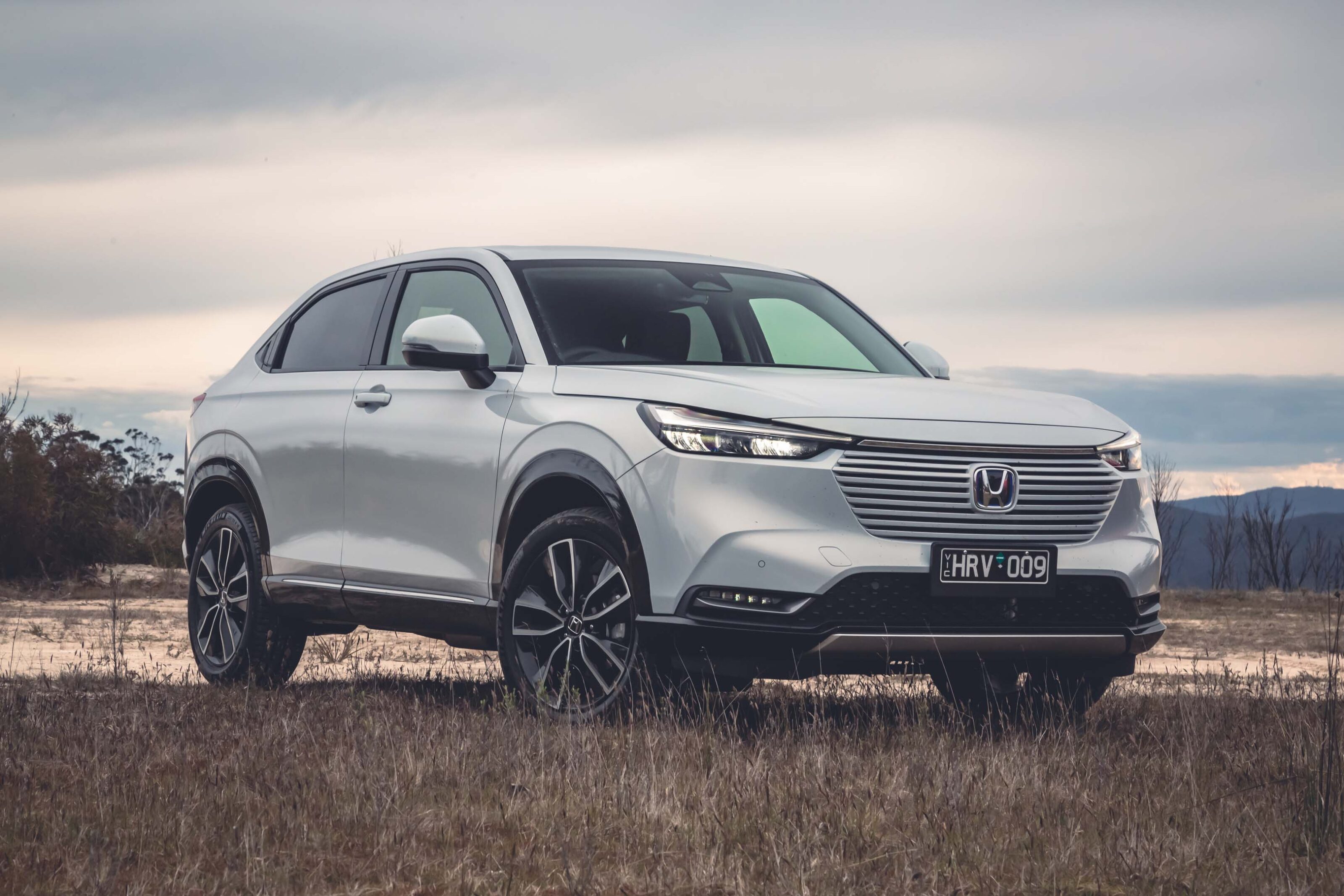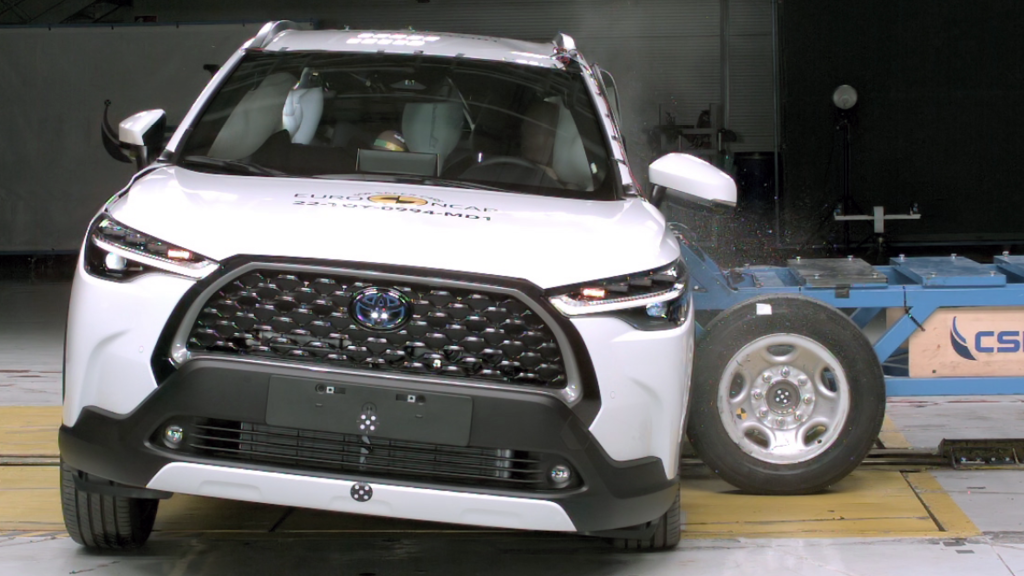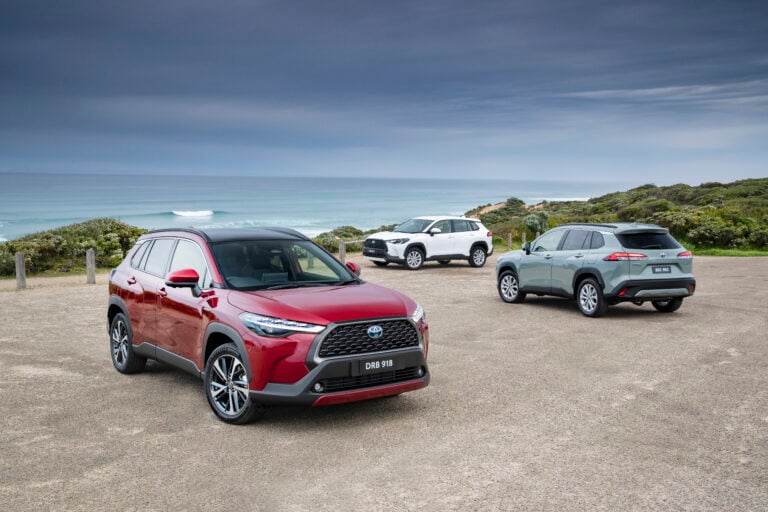
Score breakdown
Things we like
- Strong performance and good fuel efficiency
- Impressively comfortable ride
- Interior and boot space leaps over C-HR
Not so much
- Uninspiring interior design
- Some features missing
- Brakes can be grabby at low speed
- Boot space nothing special
Just when you thought Australia’s most popular brand had every conceivable SUV angle covered, along comes the Toyota Corolla Cross.
Adopting and adapting the company’s famous small-car nameplate, the Corolla Cross is to small SUVs what the Yaris Cross is to light SUVs. It slots in between the C-HR compact SUV and RAV4 medium SUV, but also with plenty of pricing overlap.
The Corolla Cross shares its platform – and 2640mm wheelbase – with the Corolla hatch and the C-HR compact SUV.
Here we review the Toyota Corolla Cross GXL AWD hybrid, a mid-upper variant in the range.

JUMP AHEAD
- How much is it, and what do you get?
- How do rivals compare on value?
- Interior comfort, space and storage
- What is it like to drive?
- How is it on fuel?
- How safe is it?
- Warranty and running costs
- VERDICT
- Specifications
How much is it, and what do you get?
The GXL AWD hybrid is the fourth most-expensive Corolla Cross, sitting below all Atmos variants.
It’s priced from $42,250 before on-road costs (or about $46,500 drive-away), meaning it overlaps with some larger SUVs including its stablemate the RAV4.
Prices start as low as $33,000 if you’re content with a non-hybrid petrol model, or from $35,500 for the more efficient petrol-electric drivetrain (both before on-road costs).
The GXL’s exterior highlights include 17-inch alloy wheels, LED headlights, foglights, privacy glass, and roof rails.
Inside, there’s a 7.0-inch digital driver display and a 10.5-inch infotainment screen.

Driver aids include adaptive cruise control, speed sign notification, blind-spot monitoring, rear cross-traffic alert and a panoramic view monitor.
There are some glaring equipment omissions, however, at this price point. The GXL lacks auto wipers, wireless smartphone charging, and a rear centre armrest. Its wheels should arguably be a size bigger, too.
All those features are included on the flagship Atmos, which also adds electric driver’s seat adjustment, heated front seats and steering wheel, a JBL premium audio system, larger (12.0-inch) digital instruments and a panoramic glass roof. Buyers, though, would need a far from inconsiderable $6800 to jump up to this variant.

How do rivals compare on value?
Take either a natural hybrid rival or a popular price rival and the Corolla Cross GXL looks undercooked in the standard gear department.
Both the $47,000 drive-away Honda HR-V e:HEV L and $41,990 (before on-road costs) Mazda CX-30 G25 Touring SP AWD have bigger 18-inch wheels, a heated steering wheel and heated front seats.
The Honda also features an auto tailgate while the Mazda has a sunroof, head-up display, leather seats, Bose audio and an electrically adjustable driver’s seat.
Toyota counters to an extent on size as it’s slightly larger than both these rivals; its 4.46m length comparing with the 4.34m HR-V and 4.4m CX-30.

Interior comfort, space and storage
Cabin space is an obvious advantage over the smaller Yaris Cross, though the Corolla Cross is also roomier compared with the C-HR. It makes for a more realistic family SUV.
The GXL’s front seats are also terrifically comfortable, with well-judged bolstering allowing space for varying torso widths while also feeling supportive. Instantly inviting, they’re also great for long journeys.
Not much is clever about storage solutions in the Corolla Cross but basics are covered: cup holders, console bin with 12-volt socket, smartphone tray (but lacking charging capability), and decently sized glovebox and door pockets (with bottle holders).

Even less thought appears to have been put into the interior design. The Corolla Cross’s cabin is dreary and uninspiring, a montage of greys and blacks bereft of any colour.
It contrasts with some of the flair seen in the C-HR and the rugged style of the RAV4. Consider its own segment, and you’ll find a more premium vibe in rivals such as the Mazda CX-30 and Honda HR-V.
Soft materials are applied to the middle dash and upper door cards, and there’s cloth lining for the console cubby and door armrests, though plastics are otherwise of the low-cost variety. A lack of damping for the console cubby lid points to further cost-cutting.

A range of blank buttons on the lower dash are another reminder that you’re not in the top-spec model.
Not even Toyota’s infotainment adds any sparkle to the dash with its uninspiring graphics and menu layout. There’s also only a single USB-A port. Apple CarPlay (wireless) and Android Auto compatibility are standard and highly recommended.
More contemporary USB-C ports are located in the ventilated rear cabin, where adults will find more legroom than in a C-HR (though not a RAV4).

Bottle holders are integrated into the rear doors, but there’s only one seatback pouch and, surprisingly for a fairly high-spec variant, there’s no centre armrest. That will disappoint kids as much as adults looking for somewhere to store their takeaway tea or coffee.
Toyota Corolla Cross boot space
The Corolla Cross’s boot space varies between models, with as much as 436 litres and as little as 380 litres.
Petrol versions, which don’t need to package hybrid battery components, have the most space; the GXL AWD hybrid’s luggage compartment is quoted at 390 litres, further affected by a less compact but more sophisticated multi-link rear suspension layout where front-drive models employ a torsion beam.
Still, that’s a massive 200 litres less than the boot space provided by a RAV4, and even a fraction less than the 390L volume of a front-wheel drive Yaris Cross.
Mini match-up!

On the upside, it’s a fair bit more than the 318 litres offered by the C-HR, while the Corolla SUV also carries an advantage over the CX-30 (317L).
Ideally, though, the Corolla Cross’s 60:40 rear seats would fold down to create a flat cargo bay but instead, there’s a stepped floor (with flaps).
All-wheel-drive models also miss out on a space-saver spare; owners instead get a puncture repair kit.
On the upsie, there’s a conveniently low loading lip, side storage, integrated hooks, four tie-downs and a cargo blind.

What is it like to drive?
The basics
| 2023 Toyota Corolla Cross GXL AWD Hybrid specs | |
|---|---|
| Drive | all-wheel |
| Drivetrain | 2.0-litre petrol + 2 electric motors |
| Transmission | continuously variable automatic |
| Power (combined) | 146kW |
| Torque (combined) | not specified |
| Fuel consumption (combined) | 4.4L/100km |
| Fuel type / tank | 91 RON / 43L |
| Boot space | 390L |
The Corolla SUV shares similar driving characteristics to both its namesake hatch, the related C-HR, and the larger RAV4. And this is a very good thing.
Toyota deserves huge credit for how it has transformed its fleet into a range of cars that are satisfying to drive.
Although the Corolla Cross’s steering is hardly communicative, its lightness and directness make Toyota’s small SUV as easy to navigate through a set of twisties as it is to manoeuvre around town.
While there’s more body roll than you’ll experience in a Corolla hatch or sedan, the overriding sense for the driver is that the Corolla SUV will negotiate corners with a higher degree of dynamic ability than typically found in its segment.

The Corolla SUV will negotiate corners with a higher degree of dynamic ability than typically found in its segment.
The strut-multi-link suspension and sensible wheel/tyre package – 17-inch rims wrapped in chubby 60-profile rubber – adeptly covers all surface bases, providing occupants with a cushioned and largely isolated ride whether coarse country roads or patchy urban streets are involved.
Of the Corolla Cross’s key driver controls, the brake pedal is the main disappointment with its grabby tendencies at low speeds.
The hybrid drivetrain isn’t the quietest when the CVT is lifting revs during harder acceleration but it’s a strong performer. Toyota quotes a believable 7.6 seconds for the 0-100km/h sprint – a time well beyond the segment average.

How is it on fuel?
As you’d hope for a petrol-electric vehicle, the Corolla Cross AWD hybrid is also respectably frugal – about 10 per cent more economical than a RAV4 based on official consumption ratings.
Combined fuel consumption is officially rated at 4.4 litres per 100km – 0.2L/100km higher than the front-wheel drive hybrid but 1.6L/100km better than the 2.0L petrol variant.
Honda’s HR-V hybrid is similar at 4.3L/100km, the GWM Jolion hybrid is higher at 5.0L/100km, and the Kia Niro hybrid leads the way with 4.0L/100km.

We’ve seen as low as 4.0L/100im indicated during our time with the GXL AWD, while a full real-world test with a brimmed and re-brimmed tank elicited a 5.9L/100km average. We ended with a 5.0L/100km indicated average after further urban time with the car.
Both petrol and hybrid drivetrains take 91 RON or an E10 blend.

How safe is it?
The Toyota Corolla Cross has achieved a maximum five-star ANCAP rating, and is well stocked with driver aids and protective features.
A centre front airbag is among the eight airbags in place, and there’s wide-ranging autonomous emergency braking, front and rear cross-traffic alerts, blind-spot monitoring and adaptive cruise control.

Warranty and running costs
The Corolla Cross is covered by a five-year, unlimited-kilometre warranty. Servicing is every 12 months or 15,000km.
Capped price servicing is cheap at $230 per visit for the first five years or 75,000km.

VERDICT
Australia’s small SUV segment has plenty of good offerings, but has been awaiting a true stand-out star. That hasn’t quite arrived in the form of the Corolla Cross, as it underwhelms in areas such as interior design, infotainment and boot space.
This new entrant, however, offers a more practical alternative to Toyota’s C-HR, while against segment rivals the Corolla Cross impresses with its road manners and the hybrid drivetrain’s mix of performance and efficiency.
2023 Toyota Corolla Cross GXL AWD hybrid specifications
| Body | 5-door, 5-seat small SUV |
|---|---|
| Drive | all-wheel |
| Drivetrain | 2.0-litre petrol engine + 2 electric motors |
| Transmission | continuously variable |
| Power (combined) | 146kW |
| Torque (combined) | not specified |
| 0-100km/h (claimed) | 7.6 seconds (claimed) |
| Fuel consumption (combined) | 4.4L/100km |
| Fuel type / tank | 91 RON / 43L |
| Boot space | 390L |
| Weight | 1545kg |
| Suspension | struts front; multilink rear |
| Length/Width/Height | 4460/1825/1620mm |
| Wheelbase | 2640mm |
| Brakes | ventilated discs front, solid discs rear |
| Tyres | Bridgestone Alenza 215/60R17 (with tyre repair kit) |
| Wheels | 17-inch alloys |
| Price | $42,250 + on-road costs ($46,512 drive-away, Sydney) |
Score breakdown
Things we like
- Strong performance and good fuel efficiency
- Impressively comfortable ride
- Interior and boot space leaps over C-HR
Not so much
- Uninspiring interior design
- Some features missing
- Brakes can be grabby at low speed
- Boot space nothing special
We recommend
-
 News
News2023 Toyota Corolla Cross pricing and features
Toyota's new small SUV, the Corolla Cross, has landed in Australia, slotting between the Yaris Cross and RAV4
-
 Comparisons
ComparisonsBest small hybrid SUV review: 2023 HR-V v Corolla Cross v Niro v CX-30 (petrol)
The increasingly important small SUV category has been crying out for new under-bonnet tech and better interior packaging. Are these four up to the task?
-
 News
NewsNew car calendar 2026: All the new cars coming to Australia next year
Here’s the WhichCar by Wheels guide to all the new cars that will launch in Australia in 2026. Check back in regularly for updates...




